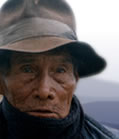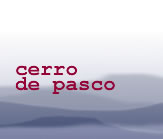 |
 |
||
 |
|||
|
RELATED THEMES culture and customs industry land OTHER LOCAL THEMES BACKGROUND |
history
A number of the narrators are knowledgeable about the region's history: they talk of Inca remains, Andean culture, the Spanish occupation, traditional farming and small-scale mining, the big haciendas - broken up in the agrarian reform - and the arrival of the big mining companies and the gringos who owned them, followed by a mass of workers from different parts of the country, and later nationalization of the industry. They also mention conflict with landowners and mining companies, war with Chile and the activities of Sendero Luminoso (Shining Path), the Maoist movement which fought a guerilla war against the government, particularly in the 1980's and early '90's. They have stories about the names of communities and key landmarks, such as lakes. One name which is often spoken with pride is that of Daniel Alcides Carrion, known as the father of Peruvian medicine. A teacher says, "Our community has a book that's been written and published by the historian Gallo in Cerro de Pasco about Daniel Alcides Carrion - he's from Quiulacocha. It's important that we know our history, our past... We've organised history and folklore courses and this has shown that some people know quite a lot about their pasts" (Peru 4). One man (Peru 25) feels that it is imperative that a detailed history of the region is soon recorded, fearing that once the regions mineral resources are used up, the towns will disappear and with them their history. The task is more urgent given that fewer and fewer people retain fluency in the language of their past: many mourn the gradual dying out of Quechua - a process now being accelerated with the increased access to (Spanish-language) education and migration to urban areas by the young, whether temporary or permanent. quotes about history"Talking specifically of the history of Quiulacocha, this goes back to the age of the Incas. It's quite certain that there were foundries in this community where the Incas processed silver. Quiulacocha comes from two words: Quiula which means seagull and cocha which means lake. As you may appreciate, the name of the community makes reference to two things which virtually don't exist anymore. There are no seagulls in the area now and the lake is dead - because of contamination from the mines." "These lands are the inheritance we've received from our ancestors, we don't want to lose them for anything. We want to recover from the pollution and preserve what is left of our customs. We're a working community, with a history, and this is what we want to leave our children." "Before the gringos appeared, it was already known that this area was rich in minerals, but they weren't mined on a large scale. When the gringos arrived things changed and their presence influenced things, the area went from being a cattle- rearing area to being a mining area and whole communities were affected." "You don't hear much Quechua nowadays. My parents don't speak it much themselves, I think my grandparents speak more. I think it's because Spanish has been imposed.Spanish is taught in the schools, not Quechua, that's why I think it's happened. They speak Spanish everywhere, all over the country and in other countries, so it's important to speak Spanish." |
|